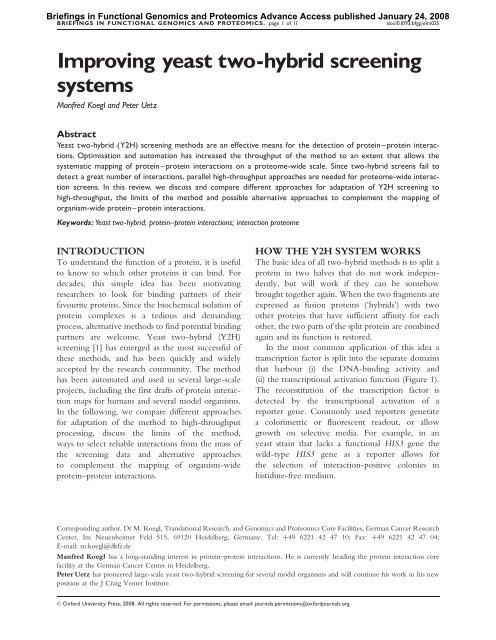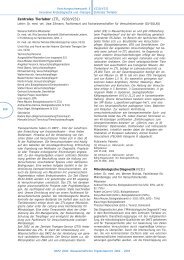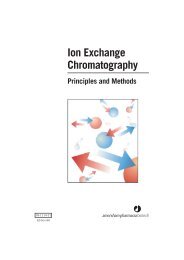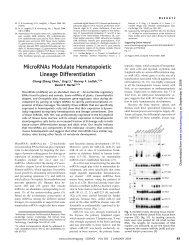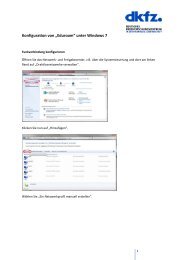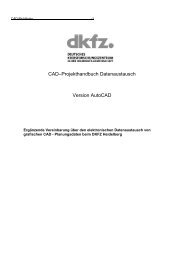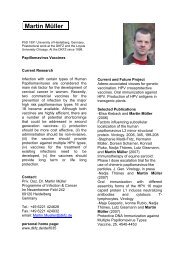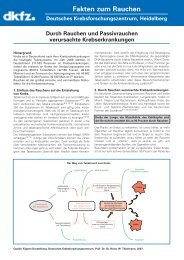Improving yeast two-hybrid screening systems - Dkfz
Improving yeast two-hybrid screening systems - Dkfz
Improving yeast two-hybrid screening systems - Dkfz
Create successful ePaper yourself
Turn your PDF publications into a flip-book with our unique Google optimized e-Paper software.
page 2 of 11Koegl and UetzFigure 1: Principle of the Y2H method. Top panel, a<strong>yeast</strong> cell expressing a transcription factor consisting ofan activation domain (AD) and a DNA-binding domain(BD). The BD binds the upstream activating sequence(UAS) and expression of an adjacent reporter gene isactivated. Middle panel, the <strong>two</strong> domains of the transcriptionfactor are expressed separately. The AD is notrecruited to the promoter of the reporter gene andtranscription is not activated. Bottom panel, <strong>two</strong> proteins,X and Y, are expressed as fusions with the AD andBD. Interaction of X withY leads to recruitment of theAD to the promoter. The activation of transcriptionfrom the reporter is interpreted as a readout for theinteraction of X with Y. The protein fused to the BD isgenerally referred to as the bait, the protein fused tothe AD called the prey.FISHING IN POOLS OF cDNASReporters that result in selective cell growth allowthe enrichment of positive colonies against a backgroundof negative cells. Using this method,complex libraries can be screened for interacting‘prey’ proteins with a ‘bait’ protein of interest. In theearly applications of Y2H <strong>screening</strong>, cDNA poolswere based on oligo (dT) or random primed cDNAsprepared from the mRNA of diverse tissues, andcloned into a plasmid suitable for Y2H <strong>screening</strong>[2, 3]. In case of <strong>yeast</strong> or prokaryotes, fragmentedgenomic DNA can be used instead of cDNA [4, 5].For <strong>screening</strong>, library clones are pooled, and <strong>yeast</strong>cells harbouring interacting bait and prey proteins areenriched by use of reporters such as HIS3.Screening of pooled libraries has been the typicaluse of the Y2H system in academic labs aiming at theisolation of binding partners for a protein of interest.As suggested by Figure 2, this method is still widelyand successfully applied. A disadvantage of librariescreated by the cloning of pools of DNA fragments isthe uncontrolled fashion in which the codingsequences of the inserts are attached to the codingsequence of the split transcription factor. In manycases, the <strong>hybrid</strong> protein will be expressed in thewrong reading frame or from the 5 0 or 3 0untranslated regions of the mRNA. The resultingnon-natural proteins provide a rich source for nonspecificinteractions that often litter the results ofY2H screens, and add to the number of falsepositives that occur in Y2H screens. To minimizefalse positives, the molecular details of the method,such as the reporter gene constructs and expressionvectors for <strong>hybrid</strong> proteins, have been fine-tuned inmany aspects (reviewed in [6–9]), significantlyreducing the noise of non-biological interactions.For an initial filtering of the raw interaction data,several technical parameters from Y2H screens areuseful. These include the number of differentreporters activated by an interaction event, and thelevel of reporter gene activation. Interactions that donot get past the hurdle of these criteria are usuallynot reported in publications although some authorshave argued that all raw data (including possible falsepositives) should be released so that they can be usedfor further improvement of filtering strategies [10].ARRAYS OF PREYSAutomation of the rate-limiting steps of the method,such as plating of cells for the selection of positives,picking of positive clones and determination of theinteraction signal allows taking Y2H <strong>screening</strong> to alarger scale, including systematic analyses of protein–protein interactions of whole organisms. As shown inFigure 2, such systematic screens make up a sizeableproportion of currently reported protein–proteininteractions identified by Y2H methods. A prerequisiteof large, systematic Y2H <strong>screening</strong> is the availabilityof cDNA clones encompassing the codingregions of the bait proteins in a suitable vector.Collections of individually cloned cDNAs comprisingthe full-length open reading frame (ORF) of themRNA are currently being generated for severalspecies (reviewed in [11–13]), in part in dedicatedefforts to provide resources for Y2H <strong>screening</strong>[14–16]. The use of recombinational cloning <strong>systems</strong>facilitates the shuttling of the coding <strong>systems</strong> betweenvectors, such that the ORFs can be readily transferredto plasmids appropriate for the expression of fusions
Yeast <strong>two</strong>-<strong>hybrid</strong> <strong>screening</strong> <strong>systems</strong> page 3 of 11Figure 2: Chronological representation of published Y2H-based data. Solid line, number of papers found in PubMedin any field using ‘<strong>two</strong> <strong>hybrid</strong>’ as a search term, per year.This number is a rough approximation of scientific papers usingthe method.Very few papers use the term in different contexts than theY2H system and its use in the identification ofnovel protein^protein interactions, as can be seen from the searches in the years before the method had been established.A caveat is that not all papers will report the use of the method in the searchable fields in PubMed. Symbolsdisplay large systematic interaction studies using theY2H method, their position on theY-axis represents the number ofhigh-confidence interactions reported. Note that the numbers are not strictly comparable, since the selection criteriafor high-confidence interaction differ among studies. Sources, sorted by year of publication are,1996: [26], 1997: [19],2000:[17],2001:[18,20,70],2002:[36],2003:[22,71],2004:[30,31,33,34,38,72],2005:[23,24,27,29,32,39,73],2006:[28, 35], 2007: [21, 40, 74].with the DNA-binding domain or activation domainin <strong>yeast</strong>. Such ‘ORFeome’ collections allow a novelstrategy for Y2H <strong>screening</strong>: instead of enrichinginteracting clones from a mixed pool, the individualclones are tested one by one for an interaction withthe bait protein. Typically, the cDNA collection ispresented in an arrayed form, and each position in thearray is tested pair-wise for interaction signals with abait protein (see also Figure 3).This approach has several advantages to the<strong>screening</strong> of pooled preys (see also Table 1): The identity of the arrayed proteins is known,such that it is not necessary to isolate and sequencethe library insert. The absence of fusions that are in the wrongreading frame or correspond to non-coding DNAavoids interaction signals from non-naturalpeptides. The library is normalised with respect to therepresentation of each protein. This is in starkcontrast to classical cDNA libraries, in whichcDNAs from highly expressed mRNAs areoverrepresented and cDNAs from lowly expressedmRNAs are rare, which results in difficulties tofind interactions with lowly expressed mRNAs. Pair-wise tests for interactions are more sensitivethan screens of large cDNA pools, probablybecause weak signals can be distinguished frombackground more easily. For example, the numberof interactions found by Uetz et al. [17] was muchlarger than the number found by the pooledlibrary used by Ito et al. [18] when the same baitwas used. However, random libraries regularlyfind more interactions than array screens becausethey include fragments that may interact whilefull-length proteins may not (e.g. Fromont-Racine et al. [19] versus Uetz et al. [17] or Rainet al. [20] versus Parrish et al. [21]).The number of pair-wise tests in such a matrixscreen increases with the square of the number ofproteins in the matrix. This is the reason why inpractice, most large-scale projects have initiallyscreened mini-pools of clones, rather than proteinpairs and then further analysed them by sequencing
Yeast <strong>two</strong>-<strong>hybrid</strong> <strong>screening</strong> <strong>systems</strong> page 5 of 11Table 1: Preys in cDNA pools versus arrays of preysDetection of interactionsClone identificationLibrary complexity(typically)Libraries screened(typically)Number of tests insystematic screensPromiscuous preysSaturationPoolsSelective growth ofpositive clones!enrichment fromlarge poolsSequencing of thelibrary insertSeveral millionRandomly clonedcDNA fragmentsNumber of screensrequired is directlyproportional to thenumber of baits(but more clonesneed to be analysedper screen)Recognised uponrepeated <strong>screening</strong>of the library.Cannot be removedfrom the poolHard to approach(e.g. ref. 78: saturationis reached in>500 screens)ArraysPair-wise testsPosition on thearray encodes theidentity of theinsertFew to thousandsIndividually clonedfull-length ORFsNumber of testsrequired increaseswith the square ofthe number ofproteins to beanalysedRecognised uponrepeated <strong>screening</strong>of the library,and removed.Saturation can beapproached in afew screens.confirmed in independent experiments. This hassimply not been possible for large-scale Y2Hexperiments, since the acceleration in data productionby Y2H analysis has not been matched yetby the improvements of ‘confirming’ methods, suchas co-immunoprecipitations. Thus, the bad news isthat the new data sources are afflicted withuncertainties that need to be taken into considerationfor their use. The good news is that the sheer mass ofdata allows the selection of reliable data byquantitative, partially statistical criteria. Such criteriamainly include the reproducibility of the interactionand the definition and exclusion of promiscuousinteractors, as outlined in the following <strong>two</strong> sections.TECHNICALVERSUS BIOLOGICALARTEFACTSFor the discussion of artefacts and their elimination,it is helpful to distinguish technical artefacts, in whichan interaction signal is generated by events otherthan a protein–protein interaction, from biologicalartefacts, where proteins truly interact, but onlywhen artificially co-expressed [41]. For example,proteins may interact in a Y2H assay without everbeing naturally expressed in the same cell. In contrastto technical artefacts, biological artefacts are genuineinteractions of bait and prey, and cannot be eliminatedby technical controls. In fact, when tested inalternative protein interaction assays, biological falsepositives will mostly be confirmed. Also, it is hard todefine false positives with certainty, since it isimpossible to give experimental proof that <strong>two</strong>proteins do under no instances bind to each other.CRITERIA FOR SELECTINGRELIABLE INTERACTIONSWe will discuss five categories of selection methodsfor reliable interactions, which are based on (i) thereproducibility of interactions, (ii) the promiscuityof interaction partners, (iii) ne<strong>two</strong>rk topology,(iv) comparisons with external data and (v) evolutionaryconservation of interaction partners. Reproducibility: Most technical artefacts areeither reproducible, or rare. Rare artefacts canarise e.g. from mutations that artificially generateinteraction signals. The likelihood that a rare eventoccurs twice independently in cells harbouringcDNAs from the same protein is extremely low.Thus, the removal of interactions that are notreproduced within the data set can be used to weedout such rare technical artefacts [22, 30, 39, 42–44]. Promiscuity: Reproducible artefacts are e.g.interaction signals that arise from non-specificbinding of the prey to the bait protein chimera.Such artificial activators of the reporter genesbecome apparent as ‘promiscuous’ preys when alibrary or an array is repeatedly screened, sincethey appear to bind to a great number of unrelatedbaits (Figure 3). These artefacts can be eliminatedfrom the data set by removing all preys that displaypromiscuities above a threshold level. The cut-offfor promiscuity, i.e. the cut-off line for how manyinteraction partners are allowed before a proteinhas to be considered promiscuous, is an arbitrarynumber. Low cut-off values for exclusion fromthe data set will increase the number of reliableinteractions in the remaining data, but at theexpense of increasing the rate of false negativeinteractions [22, 39]. Topology: The definition of a cut-off promiscuityvalue as a criterion to exclude interactions from
page 6 of 11Koegl and Uetzlikely to be expressed at the same time, and tointeract genetically with each other [23, 48–51].These criteria are most useful to assess the overallquality of a data set, and to test the usefulness ofselection criteria [52]. Conservation: Lastly, interactions have beenshown to be more likely if they are conserved inevolution, as evidenced by paralogous or homologousinteracting proteins [24, 39, 48].Figure 4: Ne<strong>two</strong>rk topologies can be used to enrichfor relevant interactions.Two hypothetical pairs of interactingproteins,V^W and X^Yare shown.The promiscuitiesof the proteins are equal in both examples. In thetop panel, there is no alternative path from V to W. Inthe bottom panel, the existence of several alternativepaths with short path lengths between X and Y lends ahigher confidence to this interaction than to the interactionof V and W.the data set is problematic. Many proteins have alarge number of genuine natural binding partners,and will be erroneously excluded from thene<strong>two</strong>rk based on their apparent promiscuity.When the interaction ne<strong>two</strong>rk is large enough, orcan be integrated with external data sets into anexisting larger ne<strong>two</strong>rk, topology metrics can beused to correct for that. These metrics test whetherthe binding partners of a protein are connected toeach other. For example, the number of commonbinding partners of an interaction pair is a positiveindicator of interaction reliability (see Figure 4 foran example) [22]. More complex algorithms thatcalculate weighted alternative path lengths forprotein pairs to derive confidence measures [45,46], or that score local topologies [47] or clusters[24, 44], have been shown to be useful in theselection of relevant interactions. Indirect support: Comparisons with external datasets have shown that proteins that bind to eachother have a higher than average likelihood to beinvolved in related cellular functions, are moreLIMITATIONS OF THE Y2H SYSTEMMany natural protein–protein interactions cannot bedetected using the Y2H method. Some proteins donot interact in the environment of the <strong>yeast</strong> nucleus,such as proteins of the secretory compartments thatrequire oxidative conditions or glycosylation forproper folding. Integral membrane proteins areunlikely to work in the context of reconstitutedtranscription factor. Many interactions are triggeredby post-translational modifications not available in<strong>yeast</strong>. Other proteins, such as active tyrosine kinases,are toxic to <strong>yeast</strong> when expressed to high levels, andcannot be used as baits. For these reasons, the rate ofinteractions not detectable by the Y2H is substantial(e.g. [18, 53]). Rajagopala et al. [54] estimated thattheir array-based Y2H screens found only 23% ofpreviously known interactions involving motilityproteins of Treponema pallidum. When data fromanother screen in Campylobacter jejuni were added, thisfraction rose to 33%. However, many additionalinteractions were found.But at least within the limits of the method, i<strong>two</strong>uld be desirable that screens be exhaustive, i.e.that they identify all interactions that can beidentified by use of the Y2H method. Screens ofpooled libraries can only asymptotically approximatesaturation. Given that those libraries have complexitiesof several millions, and weakly expressedproteins are underrepresented, most screens aresubsaturating. In contrast, array-based Y2H screenscan theoretically be comprehensively screened.However, comparisons of the presently availabledata sets for <strong>yeast</strong> (see Figure 3 for an example)[17, 18, 53], fly [22, 31, 32] and man [55] show thatin all cases, the overlap of interacting data is minimal,mainly due to the fact that most of the screens are farfrom exhaustive. Moreover, variations in the detailsof the Y2H protocol, such as the vectors used, thenature of the re-constituted transcription factor andthe libraries screened, have a great impact on the
Yeast <strong>two</strong>-<strong>hybrid</strong> <strong>screening</strong> <strong>systems</strong> page 7 of 11interactions that can be retrieved. Evidently, dueto the relatively low detection rate of the Y2Hsystem, other methods will be needed to approachthe complete mapping of human proteome, orthat of model organisms. Apart from biochemicalfractionation of protein complexes followed by massspectrometry to analyse their components, severalother methods may be apt for the task.ADDING EDGES: ALTERNATIVEPROTEIN INTERACTION ASSAYSAt the time of inception of the Y2H method,arrayed libraries were not available for <strong>screening</strong> inpair-wise interaction tests. Interacting protein pairshad to be isolated from complex mixtures of proteinsor from complex libraries, and one of the greatadvantages of Y2H <strong>screening</strong> compared to otherinteraction tests was its ability to enrich for clones ofinteracting proteins from a large pool. The availabilityof ORFeome collections and the developmentof methods that allow thousands of pair-wiseinteraction tests in parallel make this advantagesomewhat obsolete. Additional methods nowbecome applicable to matrix-type interactionscreens, although their advantages or disadvantageswill only become clearer when more data isavailable. Three of them are discussed subsequently.PROTEIN AND PEPTIDEMICROARRAYSMicroarrays have led to a tremendous parallelisationin the analysis of nucleic acids. For proteins,microarray technology (reviewed in [56]) is still inan earlier stage of development. Problems with theexpression, purification, storage and stability of largesets of native proteins still severely hamper progressin the field. To date, proteome-wide arrays useful forprotein interaction studies have been generated onlyfor <strong>yeast</strong> proteins. In a pioneering project, thesearrays were used to identify novel calmodulinbindingproteins [57]. Apart from <strong>yeast</strong> proteins,protein interaction studies using protein microarrayshave been centred on particular protein families ordomains, such as the SH2 domain [58] or the PDZdomain [59]. Possibly, the use of nucleic acidprogrammable protein arrays (NAPPA) may providea route for the cost-effective generation of proteinchips useful for the study of protein–proteininteractions [60]. For NAPPA chips, DNA moleculesare spotted that guide the in situ production ofrecombinant proteins by a coupled in vitro transcriptionand translation reaction. The expressed taggedproteins are captured by specific antibodies spottedonto the same spot as the DNA. The immobilisedarray can be probed for binding with an alternativelytagged soluble protein. In a proof-of-conceptexperiment, this method has been used to detectprotein–protein interactions among 29 humanreplication initiation proteins [60].PROTEIN COMPLEMENTATIONAND ALTERNATIVE TWO-HYBRIDASSAYSUsing a similar principle as Y2H tests, proteincomplementation assays (PCAs) use <strong>two</strong> proteinstagged with <strong>two</strong> fragments of a reporter protein(reviewed in [61]). Upon interaction of the proteins,the <strong>two</strong> fragments can reconstitute the activereporter protein, providing a readout for theinteraction. A great variety of proteins lend themselvesto use in PCAs [61]. Some of them have directread-outs, such as luciferase enzymes [62, 63], otherhave indirect read-outs, such as the split ubiquitin([64] reviewed in [65]) or the split tobacco etch virus(TEV) system [66]. The split ubiquitin system is wellmatured, and has been applied in a successful effortto map hundreds of protein–protein interactionsinvolving <strong>yeast</strong> membrane proteins [67]. In the splitTEV system, the split enzyme is a protease fromTEV. This amino acid motif recognised by thisprotease is absent in mammalian proteins, such that itcan be expressed in a mammalian cell withoutinflicting damage on the cellular proteins. Activationof TEV causes the liberation of a transcription factorfrom an inactive complex, which can be read outdirectly by reporter proteins (Figure 5A). Anotheralternative <strong>two</strong>-<strong>hybrid</strong> assay that has been shown tobe amenable to cDNA library <strong>screening</strong> is theMAPPIT system, which is based on the interactiondependentactivation of STAT transcriptionalregulators by a chimeric receptor coupled withtranscriptional reporters [68].QUANTITATIVECO-PRECIPITATION USINGLUCIFERASE-TAGGED PROTEINSThe most straightforward concept to test for aprotein–protein interaction is to purify one of theproteins, and test for the presence of the other.
Yeast <strong>two</strong>-<strong>hybrid</strong> <strong>screening</strong> <strong>systems</strong> page 9 of 11AcknowledgementsWe are grateful to Frank Schwarz., Christian Maercker, GeraldNyakatura and Dirk Kuck for critical reading of the manuscriptand to Bernd Korn, Ralf Tolle and Joachim Uhrig for helpfuldiscussions. This project has been supported by the NationaleGenomforschungsnetz (PSR-S19T039).References1. Fields S, Song O. A novel genetic system to detect proteinproteininteractions. Nature 1989;340:245–6.2. Chevray PM, Nathans D. Protein interaction cloning in<strong>yeast</strong>: identification of mammalian proteins that react withthe leucine zipper of Jun. Proc Natl Acad Sci USA 1992;89:5789–93.3. Staudinger J, Perry M, Elledge SJ, et al. Interactions amongvertebrate helix-loop-helix proteins in <strong>yeast</strong> using the <strong>two</strong><strong>hybrid</strong>system. JBiolChem1993;268:4608–11.4. Chien CT, Bartel PL, Sternglanz R, et al. The <strong>two</strong>-<strong>hybrid</strong>system: a method to identify and clone genes for proteinsthat interact with a protein of interest. Proc Natl Acad SciUSA 1991;88:9578–82.5. Yang X, Hubbard EJ, Carlson M. A protein kinase substrateidentified by the <strong>two</strong>-<strong>hybrid</strong> system. Science 1992;257:680–2.6. Bartel P, Chien CT, Sternglanz R, etal. Elimination of falsepositives that arise in using the <strong>two</strong>-<strong>hybrid</strong> system.Biotechniques 1993;14:920–4.7. Serebriiskii IG, Golemis EA. Two-<strong>hybrid</strong> system and falsepositives. Approaches to detection and elimination. MethodsMol Biol 2001;177:123–34.8. Vidalain PO, Boxem M, Ge H, etal. Increasing specificity inhigh-throughput <strong>yeast</strong> <strong>two</strong>-<strong>hybrid</strong> experiments. Methods2004;32:363–70.9. Gietz RD. Yeast <strong>two</strong>-<strong>hybrid</strong> system <strong>screening</strong>. Methods MolBiol 2006;313:345–71.10. Hart GT, Ramani AK, Marcotte EM. How complete arecurrent <strong>yeast</strong> and human protein-interaction ne<strong>two</strong>rks?Genome Biol 2006;7:120.11. Brizuela L, Richardson A, Marsischky G, et al. TheFLEXGene repository: exploiting the fruits of the genomeprojects by creating a needed resource to face the challengesof the post-genomic era. Arch Med Res 2002;33:318–24.12. Brasch MA, Hartley JL, Vidal M. ORFeome cloning and<strong>systems</strong> biology: standardized mass production of the partsfrom the parts-list. Genome Res 2004;14:2001–9.13. Temple G, Lamesch P, Milstein S, et al. Fromgenometoproteome: developing expression clone resources for thehuman genome. Hum Mol Genet 2006;15(Spec No 1):R31–43.14. Hudson JR, Jr, Dawson EP, Rushing KL, et al. Thecomplete set of predicted genes from Saccharomyces cerevisiaein a readily usable form. Genome Res 1997;7:1169–73.15. Parrish JR, Limjindaporn T, Hines JA, et al. Highthroughputcloning of Campylobacter jejuni ORfs by in vivorecombination in Escherichia coli. JProteomeRes 2004;3:582–6.16. Lamesch P, Li N, Milstein S, et al. hORFeome v3.1: aresource of human open reading frames representing over10,000 human genes. Genomics 2007;89:307–15.17. Uetz P, Giot L, Cagney G, et al. A comprehensive analysisof protein-protein interactions in Saccharomyces cerevisiae.Nature 2000;403:623–7.18. Ito T, Chiba T, Ozawa R, et al. A comprehensive <strong>two</strong><strong>hybrid</strong>analysis to explore the <strong>yeast</strong> protein interactome.Proc Natl Acad Sci USA 2001;98:4569–74.19. Fromont-Racine M, Rain JC, Legrain P. Toward afunctional analysis of the <strong>yeast</strong> genome through exhaustive<strong>two</strong>-<strong>hybrid</strong> screens. Nat Genet 1997;16:277–82.20. Rain JC, Selig L, De Reuse H, et al. The protein-proteininteraction map of Helicobacter pylori. Nature 2001;409:211–5.21. Parrish JR, Yu J, Liu G, et al. A proteome-wide proteininteraction map for Campylobacter jejuni. Genome Biol 2007;8:R130.22. Giot L, Bader JS, Brouwer C, et al. A proteininteraction map of Drosophila melanogaster. Science 2003;302:1727–36.23. Rual JF, Venkatesan K, Hao T, et al. Towards a proteomescalemap of the human protein-protein interactionne<strong>two</strong>rk. Nature 2005.24. Stelzl U, Worm U, Lalowski M, et al. A human proteinproteininteraction ne<strong>two</strong>rk: a resource for annotating theproteome. Cell 2005;122:957–68.25. Zhong J, Zhang H, Stanyon CA, et al. A strategy forconstructing large protein interaction maps using the <strong>yeast</strong><strong>two</strong>-<strong>hybrid</strong> system: regulated expression arrays and <strong>two</strong>phasemating. Genome Res 2003;13:2691–9.26. Bartel PL, Roecklein JA, SenGupta D, et al. A proteinlinkage map of Escherichia coli bacteriophage T7. Nat Genet1996;12:72–7.27. Hackbusch J, Richter K, Muller J, et al. A central role ofArabidopsis thaliana ovate family proteins in ne<strong>two</strong>rking andsubcellular localization of 3-aa loop extension homeodomainproteins. Proc Natl Acad Sci USA 2005;102:4908–12.28. Uetz P, Dong YA, Zeretzke C, et al. Herpesviral proteinne<strong>two</strong>rks and their interaction with the human proteome.Science 2006;311:239–42.29. LaCount DJ, Vignali M, Chettier R, et al. A proteininteraction ne<strong>two</strong>rk of the malaria parasite Plasmodium falciparum.Nature 2005;438:103–7.30. Li S, Armstrong CM, Bertin N, et al. A map of theinteractome ne<strong>two</strong>rk of the metazoan C. elegans. Science2004;303:540–3.31. Stanyon CA, Liu G, Mangiola BA, et al. A Drosophilaprotein-interaction map centered on cell-cycle regulators.Genome Biol 2004;5:R96.32. Formstecher E, Aresta S, Collura V, etal. Protein interactionmapping: a Drosophila case study. Genome Res 2005;15:376–84.33. Colland F, Jacq X, Trouplin V, et al. Functional proteomicsmapping of a human signaling pathway. Genome Res 2004;14:1324–32.34. Goehler H, Lalowski M, Stelzl U, et al. A protein interactionne<strong>two</strong>rk links GIT1, an enhancer of huntingtinaggregation, to Huntington’s disease. Mol Cell 2004;15:853–65.35. Lim J, Hao T, Shaw C, et al. A protein-protein interactionne<strong>two</strong>rk for human inherited ataxias and disorders ofPurkinje cell degeneration. Cell 2006;125:801–14.
page 10 of 11Koegl and Uetz36. Nakayama M, Kikuno R, Ohara O. Protein-proteininteractions between large proteins: <strong>two</strong>-<strong>hybrid</strong> <strong>screening</strong>using a functionally classified library composed of longcDNAs. Genome Res 2002;12:1773–84.37. Vollert CS, Uetz P. The phox homology (PX) domainprotein interaction ne<strong>two</strong>rk in <strong>yeast</strong>. MolCellProteomics2004;3:1053–64.38. Lehner B, Sanderson CM. A protein interaction frameworkfor human mRNA degradation. Genome Res 2004;14:1315–23.39. Albers M, Kranz H, Kober I, et al. Automated <strong>yeast</strong> <strong>two</strong><strong>hybrid</strong><strong>screening</strong> for nuclear receptor-interacting proteins.Mol Cell Proteomics 2005;4:205–13.40. Calderwood MA, Venkatesan K, Xing L, et al. Epstein-Barrvirus and virus human protein interaction maps. Proc NatlAcad Sci USA 2007;104:7606–11.41. Cusick ME, Klitgord N, Vidal M, et al. Interactome:gateway into <strong>systems</strong> biology. Hum Mol Genet 2005;14(Spec No. 2):R171–81.42. Uetz P, Hughes RE. Systematic and large-scale <strong>two</strong>-<strong>hybrid</strong>screens. Curr Opin Microbiol 2000;3:303–8.43. Uetz P. Two-<strong>hybrid</strong> arrays. Curr Opin Chem Biol 2002;6:57–62.44. Sharan R, Suthram S, Kelley RM, et al. Conserved patternsof protein interaction in multiple species. Proc Natl Acad SciUSA 2005;102:1974–9.45. Chen J, Hsu W, Lee ML, et al. Discovering reliableprotein interactions from high-throughput experimentaldata using ne<strong>two</strong>rk topology. Artif Intell Med 2005;35:37–47.46. Chen J, Hsu W, Lee ML, et al. Increasing confidence ofprotein interactomes using ne<strong>two</strong>rk topological metrics.Bioinformatics 2006;22:1998–2004.47. Saito R, Suzuki H, Hayashizaki Y. Construction ofreliable protein-protein interaction ne<strong>two</strong>rks with a newinteraction generality measure. Bioinformatics 2003;19:756–63.48. Deane CM, Salwinski L, Xenarios I, et al. Proteininteractions: <strong>two</strong> methods for assessment of the reliabilityof high throughput observations. Mol Cell Proteomics 2002;1:349–56.49. von Mering C, Krause R, Snel B, et al. Comparativeassessment of large-scale data sets of protein-proteininteractions. Nature 2002;417:399–403.50. Deng M, Sun F, Chen T. Assessment of the reliability ofprotein-protein interactions and protein function prediction.Pac Symp Biocomput 2003:140–51.51. Bader JS, Chaudhuri A, Rothberg JM, et al. Gainingconfidence in high-throughput protein interaction ne<strong>two</strong>rks.Nat Biotechnol 2004;22:78–85.52. Suthram S, Shlomi T, Ruppin E, et al. A direct comparisonof protein interaction confidence assignment schemes. BMCBioinformatics 2006;7:360.53. Reguly T, Breitkreutz A, Boucher L, et al. Comprehensivecuration and analysis of global interaction ne<strong>two</strong>rks inSaccharomyces cerevisiae. JBiol 2006;5:11.54. Rajagopala SV, Titz B, Goll J, et al. The protein ne<strong>two</strong>rk ofbacterial motility. Mol Syst Biol 2007;3:128.55. Ramirez F, Schlicker A, Assenov Y, et al. Computationalanalysis of human protein interaction ne<strong>two</strong>rks. Proteomics2007;7:2541–52.56. Hall DA, Ptacek J, Snyder M. Protein microarraytechnology. Mech Ageing Dev 2007;128:161–7.57. Zhu H, Bilgin M, Bangham R, et al. Global analysis ofprotein activities using proteome chips. Science 2001;293:2101–5.58. Jones RB, Gordus A, Krall JA, et al. A quantitative proteininteraction ne<strong>two</strong>rk for the ErbB receptors using proteinmicroarrays. Nature 2006;439:168–74.59. Stiffler MA, Chen JR, Grantcharova VP, et al. PDZ domainbinding selectivity is optimized across the mouse proteome.Science 2007;317:364–9.60. Ramachandran N, Hainsworth E, Bhullar B, et al.Self-assembling protein microarrays. Science 2004;305:86–90.61. Michnick SW, Ear PH, Manderson EN, et al. Universalstrategies in research and drug discovery based on proteinfragmentcomplementation assays. Nat Rev Drug Discov2007;6:569–82.62. Ozawa T, Kaihara A, Sato M, et al. Split luciferase as anoptical probe for detecting protein-protein interactions inmammalian cells based on protein splicing. AnalChem 2001;73:2516–21.63. Paulmurugan R, Umezawa Y, Gambhir SS. Noninvasiveimaging of protein-protein interactions in living subjectsby using reporter protein complementation and reconstitutionstrategies. Proc Natl Acad Sci USA 2002;99:15608–13.64. Johnsson N, Varshavsky A. Split ubiquitin as a sensor ofprotein interactions in vivo. Proc Natl Acad Sci USA 1994;91:10340–4.65. Lehming N. Analysis of protein-protein proximities usingthe split-ubiquitin system. Brief Funct Genomic Proteomic2002;1:230–8.66. Wehr MC, Laage R, Bolz U, et al. Monitoring regulatedprotein-protein interactions using split TEV. Nat Methods2006;3:985–93.67. Miller JP, Lo RS, Ben-Hur A, et al. Large-scale identificationof <strong>yeast</strong> integral membrane protein interactions.Proc Natl Acad Sci USA 2005;102:12123–8.68. Eyckerman S, Verhee A, der Heyden JV, et al. Design andapplication of a cytokine-receptor-based interaction trap.Nat Cell Biol 2001;3:1114–9.69. Gavin AC, Bosche M, Krause R, et al. Functionalorganization of the <strong>yeast</strong> proteome by systematic analysisof protein complexes. Nature 2002;415:141–7.70. Krogan NJ, Cagney G, Yu H, et al. Global landscape ofprotein complexes in the <strong>yeast</strong> Saccharomycescerevisiae. Nature2006;440:637–43.71. Bouwmeester T, Bauch A, Ruffner H, et al. A physicaland functional map of the human TNF-alpha/NF-kappa B signal transduction pathway. Nat Cell Biol2004;6:97–105.72. Barrios-Rodiles M, Brown KR, Ozdamar B, et al. Highthroughputmapping of a dynamic signaling ne<strong>two</strong>rk inmammalian cells. Science 2005;307:1621–5.73. Suzuki H, Fukunishi Y, Kagawa I, et al. Protein-proteininteraction panel using mouse full-length cDNAs. GenomeRes 2001;11:1758–65.74. Suzuki H, Saito R, Kanamori M, et al. The mammalianprotein-protein interaction database and its viewing systemthat is linked to the main FANTOM2 viewer. Genome Res2003;13:1534–41.
Yeast <strong>two</strong>-<strong>hybrid</strong> <strong>screening</strong> <strong>systems</strong> page 11 of 1175. Lehner B, Semple JI, Brown SE, et al. Analysis of ahigh-throughput <strong>yeast</strong> <strong>two</strong>-<strong>hybrid</strong> system and its use topredict the function of intracellular proteins encoded withinthe human MHC class III region. Genomics 2004;83:153–67.76. de Folter S, Immink RG, Kieffer M, et al. Comprehensiveinteraction map of the Arabidopsis MADS Box transcriptionfactors. Plant Cell 2005;17:1424–33.77. Lawit SJ, O’Grady K, Gurley WB, et al. Yeast <strong>two</strong>-<strong>hybrid</strong>map of Arabidopsis TFIID. Plant Mol Biol 2007;64:73–87.78. Kaltenbach LS, Romero E, Becklin RR, et al. Huntingtininteracting proteins are genetic modifiers of neurodegeneration.PLOS Genetics 2007;e82.79. Jin F, Avramova L, Huang J, Hazbun T. A <strong>yeast</strong> <strong>two</strong>-<strong>hybrid</strong>smart-pool-array system for protein-interaction mapping.Nat Methods 2007;4:405–7.


